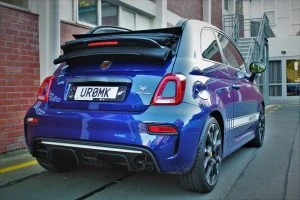Hydrogen Fuel Is The Nexo Step.
Hyundai Australia has unveiled their Nexo vehicle. Powered solely by hydrogen, it’s set to be a game-changer if the right infrastructure is put in place. For now, a fleet of twenty will roam the streets of Canberra during a trial phase. Nexo is powered by a hydrogen fuel cell, rated at 95kW, coupled to an electric motor. It generates 120kW and 395Nm, and has a theoretical range of over 660 kilometres. Here’s how it works, says Hyundai.
Nexo is powered by a hydrogen fuel cell, rated at 95kW, coupled to an electric motor. It generates 120kW and 395Nm, and has a theoretical range of over 660 kilometres. Here’s how it works, says Hyundai.
Hydrogen gas is stored in high-pressure tanks and is sent from these to the fuel cells. It mixes with oxygen taken straight from the atmosphere and reacts across a “catalyst membrane” and creates electricity for the engine and battery, and water as the sole by-product. Excess power is stored in the battery system. Fuel Cell Electric Vehicles, or FCEVs, can be refilled in virtually the same time as a petrol fuel tank.
2021 Convertibles with Reasonable Prices

Abarth 595 Convertible
Very cute and not too expensive, the Abarth 595 Convertible has stacks of style and plenty of road presence even though it happens to come in rather small packaging. The Competizione is the more expensive (around $36k) of the two models available but offers more features and more grunt. You have FWD and the weight of the car is only a little over 1000 kg, so the driving experience is dynamic and loads of fun. The 1.4-litre Turbo unleaded petrol engine offers 132 kW and 250 Nm in the Competizione (0-100 km/h in less than 7 seconds, top speed 220k m/h) and 107 kW and 206 Nm in the standard version. Fuel economy sits on average at around 6-to-6.5 litres/100 km. With a 3-year 150,000 km warranty and 3 years roadside assist you are well covered. Expect to pay from around $35k for the base model and $41 k for the Competizione.
2021 Mitsubishi Outlander GSR PHEV: Private Fleet Car Review
Hybrid technology has fast become part of the automotive landscape. First seen in Toyota’s Prius, it hasn’t taken long to trickle down into mainstream passenger cars and SUVs. However, a new form of hybrid tech, the plug-in hybrid version, has taken more time. A front-runner for SUV PHEVs has been Mitsubishi with their Outlander. The Range: In 2021 they offer three; the ES, GSR, and Exceed. We spent a week with the sporting tuned (by Bilstein, no less) GSR Hybrid. It’s priced at $56,490 drive-away, and has a pair of electric motors for front and rear wheel drive simultaneously via a single ratio transmission. Main power is from the standard 2.4L petrol engine with 94kW and 199Nm. That’s on 91RON unleaded.
The Range: In 2021 they offer three; the ES, GSR, and Exceed. We spent a week with the sporting tuned (by Bilstein, no less) GSR Hybrid. It’s priced at $56,490 drive-away, and has a pair of electric motors for front and rear wheel drive simultaneously via a single ratio transmission. Main power is from the standard 2.4L petrol engine with 94kW and 199Nm. That’s on 91RON unleaded. The electric motors offer 60kW (front) and 70kW (rear), and are charged via one of two ports on the rear right quarter. The petrol tank is good for 45L and the economy is rated as 1.9L/100km on 91RON unleaded. Although Mitsubishi’s system constantly updates as you drive, in the Hybrid there are sub-menus to check charge rates, battery usage, and fuel over given times.
The electric motors offer 60kW (front) and 70kW (rear), and are charged via one of two ports on the rear right quarter. The petrol tank is good for 45L and the economy is rated as 1.9L/100km on 91RON unleaded. Although Mitsubishi’s system constantly updates as you drive, in the Hybrid there are sub-menus to check charge rates, battery usage, and fuel over given times.
Our final figure would be somewhere around the 5.5L/100km mark if we read the graph correctly. That’s on our usual 70/30 urban to highway runs. The battery is rated at 12kWh and has an on-board charger rate of 3.7kW. using a standard home system it’s somewhere between 6.5 to 7 hours to “fill”. The plugs are Type 1 and CHAdeMO. Drive is engaged via a simple lever with an electronic Park function. There is also an adjustable Brake mode to recover more kinetic energy if possible. This works best on longer downhill runs.
The battery is rated at 12kWh and has an on-board charger rate of 3.7kW. using a standard home system it’s somewhere between 6.5 to 7 hours to “fill”. The plugs are Type 1 and CHAdeMO. Drive is engaged via a simple lever with an electronic Park function. There is also an adjustable Brake mode to recover more kinetic energy if possible. This works best on longer downhill runs.
Mercedes Commits to a Broad Line-up, Despite Fixed-Price Strategy
Hot on the heels of Japanese rival Honda, Mercedes-Benz is set to restructure its business as it moves towards an agency-style structure in the new car market down under. The move is pencilled in for January 1, 2022, although the luxury auto-maker is still working to put the finishing touches on all the details before then.